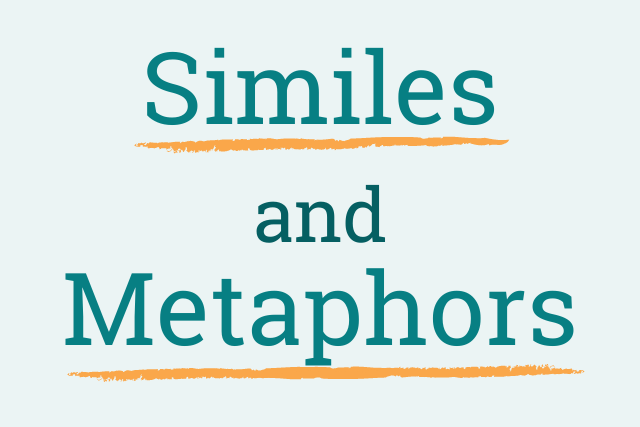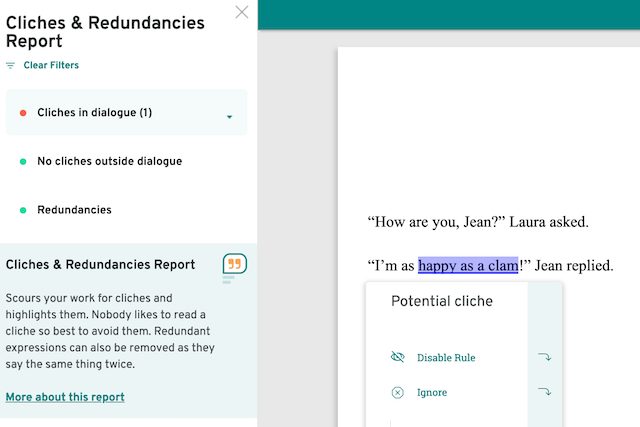
If you can’t tell the difference between a simile and a metaphor, you’re not alone. Both are commonly confused types of figurative language. You will often spot them in fiction, song lyrics, and poetry. They compare two unlike things for dramatic effect.
Similes use the words ‘like’ or ‘as’ to compare. Metaphors differ by saying that something is something else. Both allow an author to emphasize, exaggerate, and add interest. They create a vivid picture in the reader’s mind.
Let’s look at the difference between the two and the effect they can have on your writing.
What Is a Simile?
A simile (pronounced si·muh·lee) is easy to spot because it will always contain the words ‘like or ‘as’. It’s a great way to suggest emotions or feelings. You can use it to exaggerate a characteristic.
“My mom always said life was like a box of chocolates. You never know what you're gonna get.” — Forrest Gump
This quotation is a famous example. It highlights how surprising life can be. The simile works because it uses something familiar and obvious to the reader. You can recall times when you’ve had a box of chocolates and had to select one not knowing what flavor you might end up with.
A true simile must compare two unlike things that have a similarity between them. For example, you can’t compare the USA with the UK as they are both countries. However, you could say, “The USA is like an elderly uncle who vaguely remembers your name,” as a person and a country are a different class of objects.
Examples of Similes
There are countless examples of common similes you will be familiar with:
- As brave as a lion
- She sings like an angel
- As cold as ice
- It was like watching grass grow
- As innocent as a lamb
- Sweet as sugar
- Work like a dog
- Shine like the stars
- As clean as a whistle
Overused similes become clichés. Avoid using them in your writing and check for them when editing your work.
Similes in Literature
You will often find similes in poetry and fiction writing. They have the power to draw the reader’s attention to a specific detail or characteristic.
“The very mystery of him excited her curiosity like a door that had neither lock nor key.” — Gone with the Wind, by Margaret Mitchell
We can all imagine the temptation to open the door. This simile highlights the curiosity of Scarlett O’Hara. It also suggests that she gives in to temptations.
“I would have given anything for the power to soothe her frail soul, tormenting itself in its invincible ignorance like a small bird beating about the cruel wires of a cage.” — Lord Jim, by Joseph Conrad
In this quotation, the commonly used simile of a bird in a cage suggests how helpless the soul is and that someone has the power to free it from its captivity.
How to Create an Effective Simile
Avoid the temptation to use common similes in your writing. Instead, treat them as an inspiration to create a new description. There is no need to keep similes to a short simple sentence. You may expand one across several sentences or a full paragraph.
Don’t compare things that are too different from each other. There must be a common element between them that isn’t forced or clumsy to read.
What Is a Metaphor?
Metaphors (pronounced meh·tuh·for) are comparisons between people, things, or places. Unlike similes, where you use the words ‘like’ or ‘as’ to make a comparison, metaphors say that something is something else.
The English language is full of metaphors and we use them all the time in everyday conversations. When it is cold and you say you are freezing, this is a metaphor because it is not literally true. It highlights and exaggerates feeling cold for dramatic effect.
“But soft, what light through yonder window breaks? It is the east, and Juliet is the sun.” — Romeo and Juliet, by William Shakespeare
This metaphor is part of a declaration of love. By calling Juliet “the sun” Romeo suggests she is the center of everything. This is far more dramatic than just saying “I love her.”
Metaphors suggest meanings to the reader and are often complex rather than focused on one point of comparison. There are many different forms of metaphor and they are used to make the reader think deeply.
Examples of Metaphors
There are thousands of commonly used metaphor examples:
- Her voice was music to his ears
- A river of tears
- The classroom was a zoo
- His stomach was a bottomless pit
- A heart of gold
- Her desk was a prison
As with similes, avoid using these clichés in your writing and create your own.

Literary Metaphors
Metaphors are subtle. They hint at several different meanings and allow the reader a personal interpretation.
“The road was a ribbon of moonlight over the purple moor.” — The Highwayman, by Alfred Noyes
This metaphor allows the reader to consider several connotations. Moonlight is a symbol of mystery and adventure but also a beacon of hope and safety in the dark. The choice of the word "ribbon" suggests an unsteady and flimsy path.
“Her mouth was a fountain of delight.” — The Storm, by Kate Chopin
You might imagine words gushing or exploding out in this character description. Fountains are showy and impressive. People gather around to admire them. Kate Chopin also encourages the reader to consider a sexual reading.
“All our words are but crumbs that fall down from the feast of the mind.” — Sand and Foam, by Khalil Gibran
This famous quotation offers ambiguity. Is Gibran suggesting that words are unimportant and should be ignored? Or is he saying they are a tantalizing taste of our minds?
Should You Use a Simile or Metaphor?
It is personal preference whether you use a simile or metaphor. Most authors would use both sparingly within their writing.
Choosing between a simile and a metaphor is deciding between clarity and power in your imagery. Similes give your reader an example and highlight one specific meaning. Metaphors allow different interpretations.
Undoubtedly, metaphors carry more strength. A good one instantly conjures up an understanding but is subtle. You can interpret it in different ways. Similes are obvious and simple but draw a clever comparison.
Edit Like a Pro With ProWritingAid:
Similes and metaphors stick in your mind and because of this, many of them have become clichés. Use ProWritingAid to check your document for clichéd phrases so that you can be sure that your writing is always fresh.

Just use the Clichés and Redundancies Report to highlight your clichés so you know where your similes and metaphors might need work.
Simile vs Metaphor: Final Thoughts
Similes and metaphors are both useful types of figurative language. The main problem is when they are imitative and overused. Aim to use only a few and make them powerful. Avoid including clichés and make sure you aren’t forcing them into your writing. They should seem natural and have a purpose.
Don’t be literal. Surprise your reader with an unusual comparison that is effective. Ask yourself — what do I want to suggest? Create your own examples and keep refining them. It is common for a writer to think of many before producing the perfect one.

